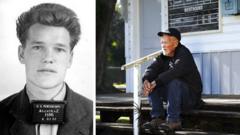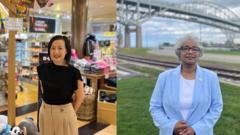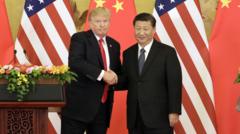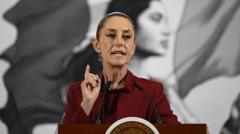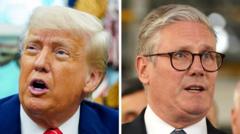As the Canadian federal election approaches, shifting political landscapes reveal surprising dynamics, with both Liberal leader Mark Carney and Conservative leader Pierre Poilievre vying to sway voters amidst global tension.
Canada’s Election Race Heats Up: Liberals Rally Against the Odds
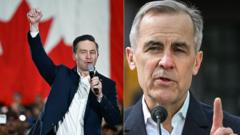
Canada’s Election Race Heats Up: Liberals Rally Against the Odds
Canada’s political climate transforms as leaders face off ahead of election day.
A heated atmosphere envelops the Canadian election season as parties ramp up their final appeals to voters. At a rally in London, Ontario, Liberal leader Mark Carney struggled to connect with a crowd skeptical of his stance against the looming threats from the United States, particularly under President Donald Trump. "President Trump is trying to break us so that America could own us," Carney asserted, eliciting boos and shouts from attendees wielding Canadian flags attached to hockey sticks.
In contrast, Conservative leader Pierre Poilievre drew large, passionate crowds to his events, resonating with a message of change. His rallying cry, "Bring it Home," taps into Canadian nationalism, challenging perceived American overreach. As the campaign enters its final stretch, how each leader addresses the Trump factor could be pivotal — with polls indicating the Liberal party holds a slim lead.
While President Trump has become a backdrop to the election narrative, Poilievre has opted for a broader focus, capitalizing on public discontent with the current Liberal government amid rising living costs and social issues. Voters like Eric and Carri Gionet from Barrie, Ontario, expressed their anxieties about their daughters' futures concerning housing, underscoring a growing frustration that could shift allegiances.
After an initial rough patch for the Liberals — who trailed the Conservatives in polls until recent months — a comeback was spurred by the departure of former Prime Minister Justin Trudeau and the appointment of Carney, who emerged as a central figure able to navigate Canada through potential economic upheavals brought on by tariffs.
As the election nears, Carney aims to bolster his appeal by portraying experience and stability, qualities he believes are critical to navigating a tense geopolitical climate. Voters remain divided, however; some express skepticism of his capabilities, while others cite his impressive résumé as a calming factor amid uncertainties tied to US relations.
On the other side, Poilievre faces challenges aligning himself distinctly apart from Trumpish ideologies. His critics have labeled him as "Trump lite," prompting him to emphasize his distinct approach to Canadian governance. Both candidates find themselves addressing major concerns around economic recovery, energy independence, and immigration, albeit from diverging perspectives.
The campaign has revealed deep regional divides, with the US-Canada relationship influencing many discussions. Other pressing issues like climate change, Indigenous rights, and immigration policy have taken a back seat, overshadowed by immediate economic concerns. As leading parties hope to secure over 38% vote share — a scenario not seen since 1975 — the political landscape remains precarious, making every voter’s choice crucial.
With the election day looming, both Carney and Poilievre continue to sharpen their messaging, aiming to capture the hearts and minds of a polarized electorate. As Carney stated, “It’s time for experience, not experiments,” countered by Poilievre's focus on the promise of transformational change, the final days of campaigning could prove decisive.
The stakes couldn’t be higher in this historic Canadian election.




